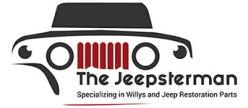Tech Specs CJ-2A: Cooling System
Click on any link below to shop now for Willys CJ-2A Jeep parts:
The cooling system of the Willys Jeep CJ-2A plays a vital role in maintaining optimal engine temperatures, ensuring reliable performance in diverse conditions. From the crossflow radiator to the water pump and an array of hoses, each component contributes to efficient heat dissipation. In this exploration of the CJ-2A cooling system, we delve into its technical specifications, highlighting key features and maintenance practices to keep your vintage Jeep running smoothly.
- Radiator Type: Crossflow Radiator
- Material: Typically copper and brass for excellent heat transfer.
- Design: Crossflow design for efficient horizontal coolant flow.
- Cooling Fins: Increase surface area for enhanced heat dissipation.
- Mounting Location: Front of the engine bay, attached to the front grille or core support.
- Radiator Cap: Standard cap with a pressure rating between 4-7 psi.
- Material: Cast iron or durable material.
- Design: Centrifugal pump design with impeller for efficient coolant circulation.
- Mounting Location: Front of the engine, connected to the engine block.
- Pulley: Driven by a belt connected to the engine crankshaft pulley.
- Seals: Mechanical seals and gaskets prevent coolant leakage.
- Shaft & Bearings: Steel shaft supported by ball or roller bearings.
- Coolant Inlet & Outlet: Connected to the lower radiator hose and the engine's cooling system.
- Upper Radiator Hose: Connects the top of the radiator to the water pump.
- Lower Radiator Hose: Connects the bottom of the radiator to the water pump or engine block.
- Heater Hose: Connects the engine to the heater core inside the cabin.
- Bypass Hose: Connects the thermostat housing to the water pump or intake manifold.
- Water Pump Bypass Hose: Connects the water pump housing to the intake manifold or thermostat housing.
- Overflow Hose: Connects the radiator overflow reservoir to the radiator or radiator cap.
- Thermostat Housing Outlet Hose: Connects the thermostat housing to the radiator or water pump.
- Radiator Cap Overflow Hose: Connected to the radiator cap and extends to the overflow reservoir.
- Coolant Inlet Hose: Connects the engine's coolant inlet to the water pump or radiator.
- Coolant Outlet Hose: Connects the engine's coolant outlet to the radiator or heater core.
Cooling System Maintenance Methods:
Regular Inspections: Check coolant level regularly; Inspect for leaks or corrosion in the radiator, hoses, water pump, and other components.
Coolant Flush: Perform a coolant flush every 2-3 years.
Radiator Cleaning: Regularly clean radiator fins from debris, dirt, and bugs.
Hose Inspection: Inspect cooling system hoses for cracks, wear, and soft spots every 6 months or with every oil change.
Pressure Cap Check: Check the radiator cap's seal and pressure relief valve.
Thermostat Inspection: Test the thermostat periodically to ensure correct operation.
Water Pump Maintenance: Check for leaks, play in the pulley, and proper circulation.
Fan and Belts: Inspect fan blades for damage and ensure proper belt tension.
Coolant Mix: Maintain the correct coolant-to-water ratio (1:1).
Additives: Consider using cooling system additives as recommended.
Cooling System Flushing: Perform a complete system flush if needed.
Temperature Gauge: Regularly monitor the temperature gauge while driving.
Radiator Cap Inspection: Check the radiator cap gasket and pressure valve.
Belt Replacement: Replace fan belts at recommended intervals.
Antifreeze Protection: Check the antifreeze protection level with a hydrometer.
Coolant Reservoir: Maintain the proper coolant level in the reservoir between the Min & Max markings.
Stay tuned for Part 4 where we talk about data plates, the electrical system, as well as appropriate gauges needed for a restoration of the CJ-2A. Preserve the classic legacy of the "Jeep" with JeepsterMan - your trusted source for authentic Jeep parts and knowledge. Subscribe now for the latest updates!

